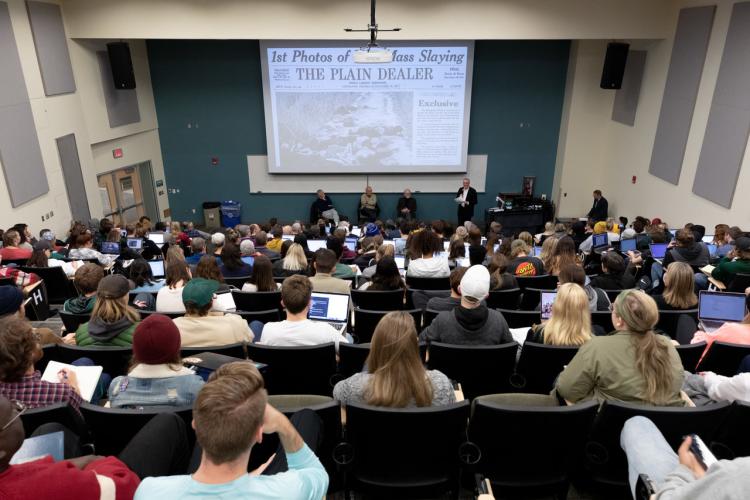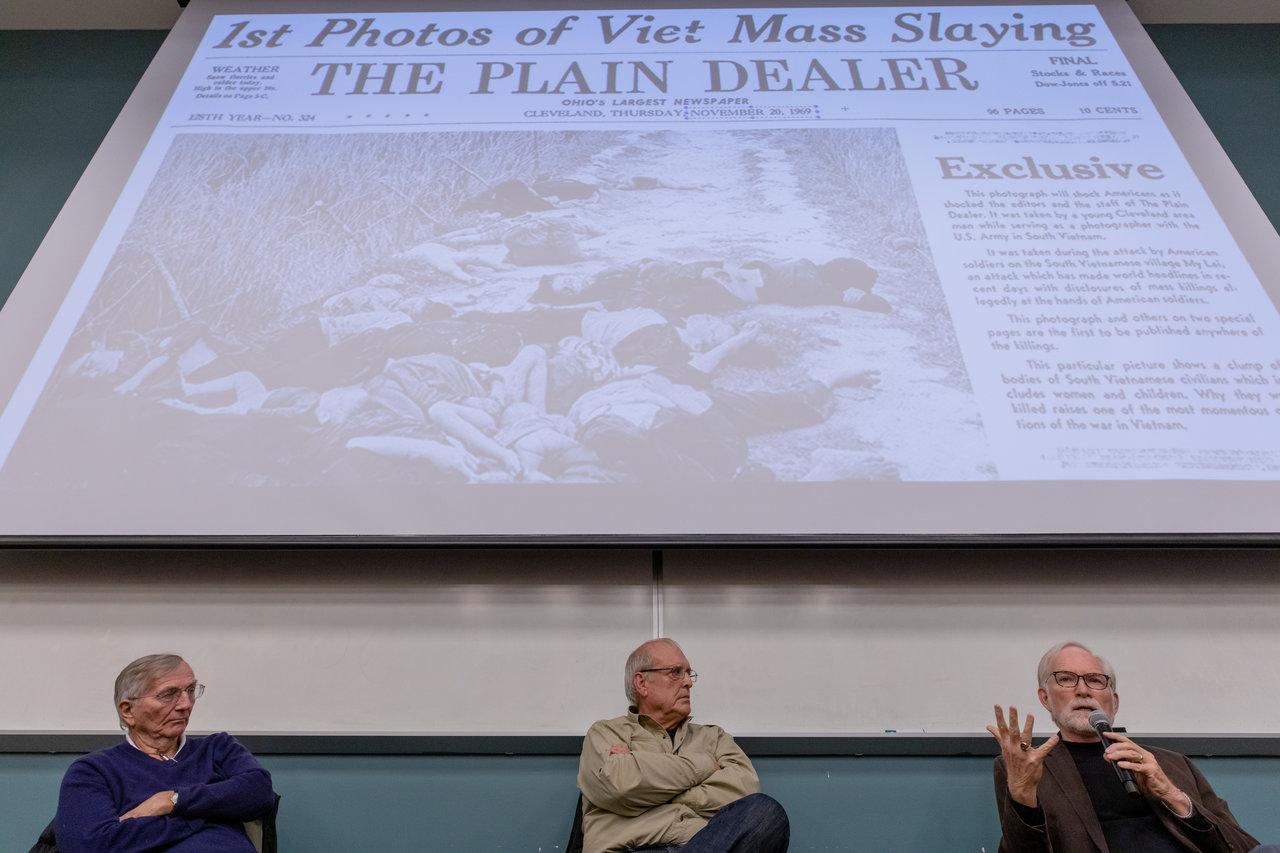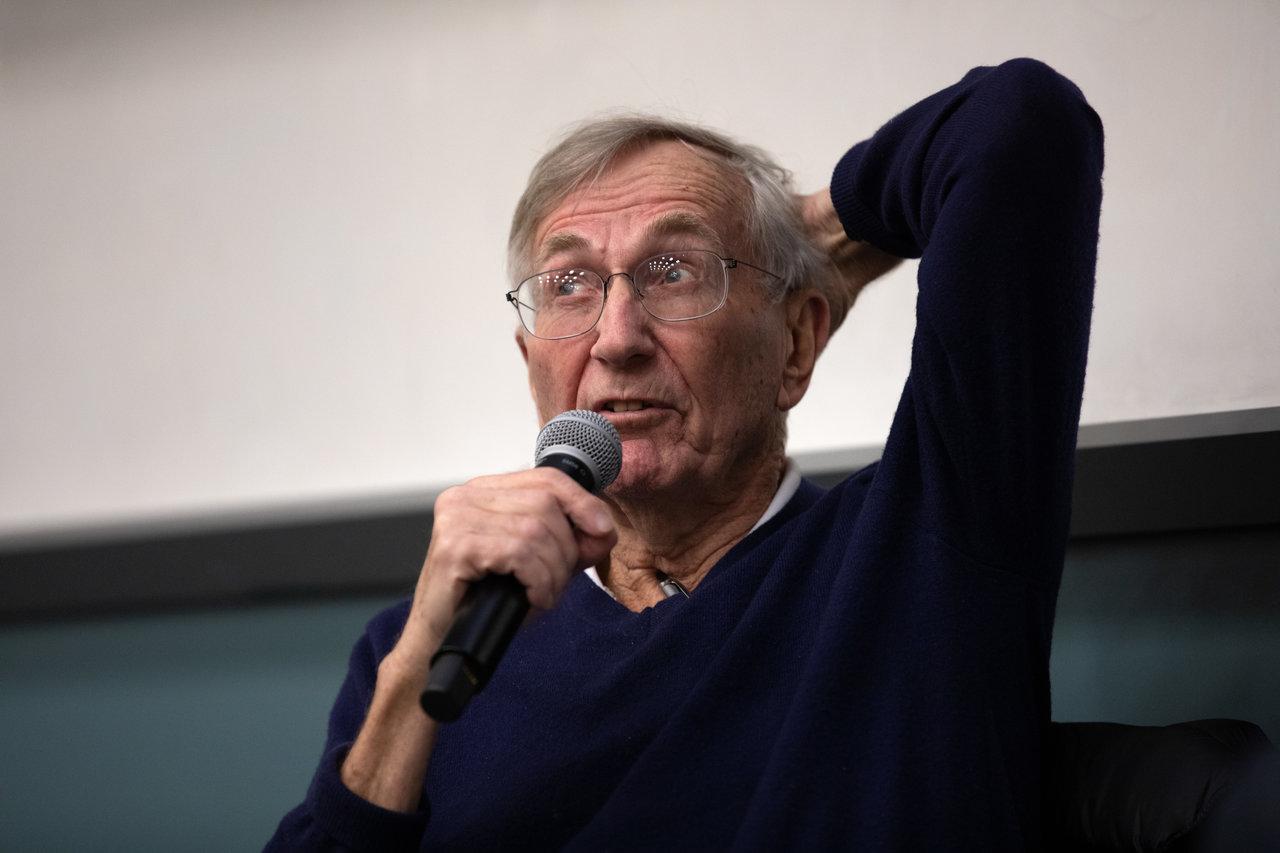
E.W. Scripps School of Journalism hosts expert panel on My Lai Massacre

On Nov. 20, 1969, the Cleveland Plain Dealer published photographs depicting the bloodshed of hundreds of civilians in a South Vietnamese village, an event that would come to be known as the My Lai Massacre. The photos were taken by Army combat photographer and former Ohio University student Ron Haeberle.
To commemorate the 50th anniversary of the publication of Haeberle’s photographs, the E.W. Scripps School of Journalism hosted a panel discussion in the Schoonover Center for Communication Nov. 19.
Veteran journalist Seymour Hersh, who won a Pulitzer Prize for breaking the My Lai story, and David Crane (BA ’72 and MA ‘73), former chief prosecutor for the United Nations Special Court for Sierra Leone, joined Haeberle on the panel. Andy Alexander, former Washington Post ombudsman (BSJ ‘72), a Scripps Howard Visiting Professional in the Scripps College of Communication, served as moderator.
“The fact that former Ohio University students played such a significant role in getting the My Lai story on the front pages of American newspapers 50 years ago reminds our students today of the impact they can have during their careers,” according to Robert Stewart, director of the journalism school.

Haeberle said he initially was met with skepticism when he returned from Vietnam and shared the photos.
“These photographs to me aren’t worth anything unless somebody talks about them,” Haeberle said. “More and more soldiers started talking about what happened there, and people started to realize that this did happen.”
Haeberle waited a month after returning to the U.S. from Vietnam before processing the color slide images taken during the assault on the My Lai village in March, 1968. He said he knew that the repercussions of having those photographs could be deadly for him.
“There were officers [in helicopters flying] above ground and they knew what was going on,” Haeberle said. “If there was going to be an investigation, we would let them come to us. But we were not going to volunteer our information.”
Hersh began his investigation of the story based on a tip he received from young military officers, but he also met with resistance when he sent it out to publications.
“It took me three and a half weeks to get anyone to even think about publishing it,” Hersh said. “Everybody passed the story… It was not a story that was going to get you a lot of friends in America. It was saying American boys were murdering people.”
Carly Curiale, an Ohio University sophomore studying history, attended the Schoonover event and said she realized how little she knew about the My Lai Massacre.
“I was really intrigued to know what happened and to hear first-hand accounts,” Curiale said. “I think it’s incredible to know that [Haeberle and Crane]… were Bobcats too.”

Crane was a sophomore at Ohio University when the My Lai Massacre story was published. When the news came out about the attack on the village, he said he was not fully aware of the extent of what was happening overseas. But his career has been shaped by events like the My Lai Massacre. Crane is the founding director of the Office of Intelligence Review in the United States Department of Defense, a unit established to ensure military personnel are informed about the laws of war and their responsibilities to uphold them.
“I was appointed into a position to create a program by which we have no more My Lais,” Crane said. “The Department of Defense really made serious intent to ensure all of our armed forces receive a law of war training as they enter service. They [soldiers] were just angry when they hit the ground [in My Lai]; they were looking for revenge and obviously the tragedy is women, children, and elderly people were the victims.”
Experts like Crane have studied My Lai and the military unit held responsible for the massacre in an attempt to prevent it from happening again. Crane explained that they learned that the soldiers felt extreme anger about losing fellow Americans in the war and wanted revenge. Their superior officers allowed them to have it, underscoring what Crane called the failure of leadership.
“Their chain of command was wrong and that shouldn’t have happened,” Crane said. “There is no apology to My Lai. The American military is not perfect and never has been but has learned from this and has tried to avoid this tragedy again. It was a huge tragedy.”
The final count of lives lost in the massacre in the village of My Lai was 504 people.
